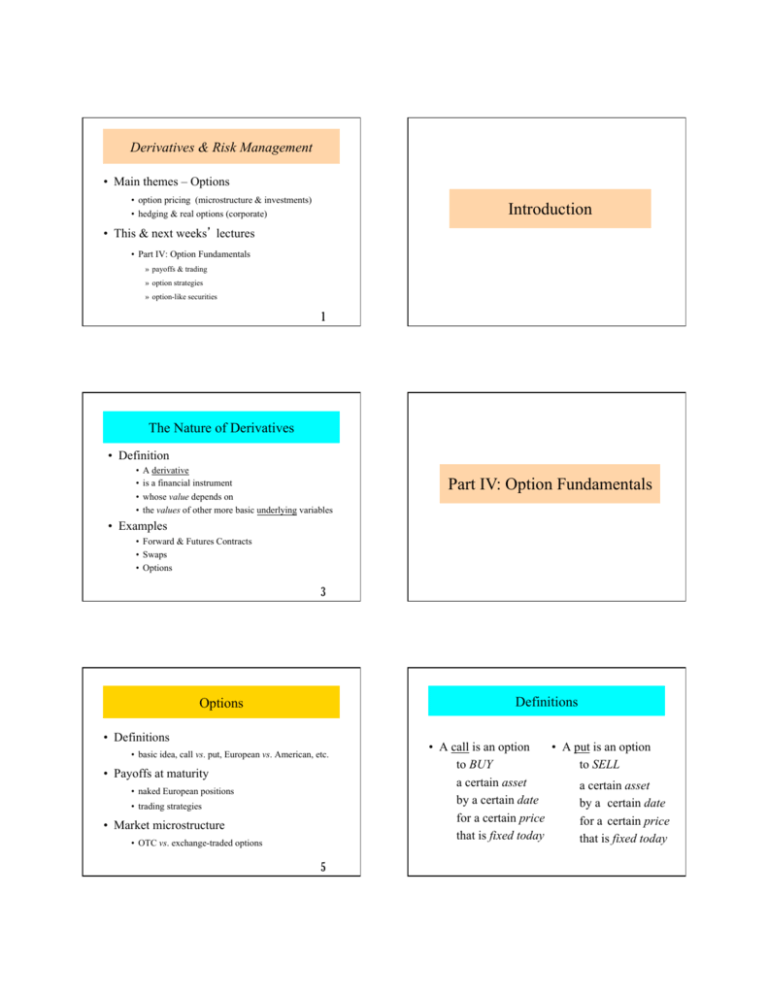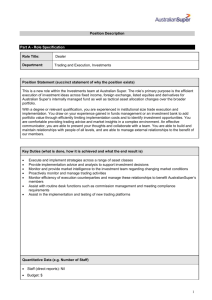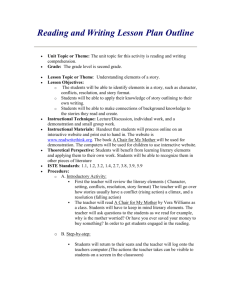Document
advertisement

Derivatives & Risk Management • Main themes – Options • option pricing (microstructure & investments) Introduction • hedging & real options (corporate) • This & next weeks’ lectures • Part IV: Option Fundamentals » payoffs & trading » option strategies » option-like securities 1 The Nature of Derivatives • Definition • A derivative • is a financial instrument • whose value depends on • the values of other more basic underlying variables Part IV: Option Fundamentals • Examples • Forward & Futures Contracts • Swaps • Options 3 Definitions Options • Definitions • basic idea, call vs. put, European vs. American, etc. • Payoffs at maturity • naked European positions • trading strategies • Market microstructure • OTC vs. exchange-traded options 5 • A call is an option • A put is an option to BUY to SELL a certain asset a certain asset by a certain date by a certain date for a certain price for a certain price that is fixed today that is fixed today Terminology Ways Derivatives (options) are Used • Invest or speculate • The party that has agreed to: – BUY • Hedge risks / change nature of asset or liability • has what is termed a LONG position • Contingent exposure – SELL • To infer views about… • has what is termed a SHORT position • … future direction of the market • … forward-looking uncertainty • To lock in arbitrage profits 7 8 Option Terminology Ways Derivatives are Used 2 • Types of Traders • Call vs. Put • right to buy vs. right to sell (bullish view vs. bearish view) • Hedgers - want to reduce risk of existing assets or liabilities • Speculators • Buying vs. Writing (= selling) • American vs. European - willing to take risk based on their forecasts • strike by a given date vs. strike at a given date • Arbitrageurs • Option premium vs. Exercise price - use risk-free trading strategies • price of the option vs. price at which buyer strikes - to exploit asset mispricings 9 Option Terminology 2 Option Payoffs at Maturity • Moneyness (Investor’s possible situations) • Naked European positions • in-the money • buyer - calls: St > X - put: - calls: Max[0, ST - X] - c - put: Max[0, X-ST] - p St < X • at-the money - • writer St = X - calls: Min[0, X - ST] + c • out-of-the-money - put: - calls: St < X - put: 10 Min[0, ST - X] + p • Realism? St > X • Time value of money? Brokerage fees (buy & strike) 11 12 Option Payoffs at Maturity 2 Option Payoffs at Maturity 3 • Profit from Long naked Call on IBM • Profit from Short naked Call on IBM (buy an IBM European call option; price = $5, strike = $100) 30 Profit ($) Profit ($) 5 0 20 10 0 -5 (write an IBM European call option; price = $5, strike = $100) 70 80 90 Terminal stock price ($) 100 110 120 130 110 70 80 90 120 100 130 Terminal stock price ($) -10 -20 -30 13 14 Option Payoffs at Maturity 4 Option Payoffs at Maturity 5 • Profit from Long naked Put on Enron • Profit from Short naked Put on Enron (buy an Enron European put option; price = $7, strike = $70) 30 Profit ($) Profit ($) 7 20 0 10 0 -7 (write an Enron European put option; price = $7, strike = $70) Terminal stock price ($) 40 50 60 70 80 90 100 40 50 Terminal stock price ($) 60 70 80 90 100 -10 -20 -30 15 Option Payoffs at Maturity Payoffs 6 • Summary (Fig.8.5): Payoff X = Strike price; ST = Price of asset at maturity Payoff X X ST Payoff ST Payoff X X ST ST 17 16 Options vs. Forwards • A forward contract • An option contract gives each party the gives the buyer the OBLIGATION to RIGHT (but not the buy or sell at a obligation) to buy or certain price sell at a certain price Profit from a LONG Naked Forward Position (Fig1.2) Profit Profit from a SHORT Naked Forward Position (Fig1.2) Profit Price of Underlying at Maturity Price of Underlying at Maturity 19 Options, Forwards and Futures 20 Trading Strategies Involving Options • Covered position Customized Standardized • Position involves the option & the underlying right OTC option exchangetraded option • Spread • Position involves 2 or more options of the same type obligation forward • Combination futures • Position involves mixture of calls & puts • Straddles, strips & straps, strangles 21 22 Trading Strategies Involving Options 2: Covered Positions Trading Strategies Involving Options 3 • Covered call (Hull, Fig. 10.1a) • Protective put (Hull, Fig. 10.1c) • what? » buy stock + buy put • what? (a.k.a. as a “married put”) » buy stock + write call » cover + naked sale • why? • why? » portfolio insurance » comparative payoffs » central banks (gold reserves) • protective put vs. stop-loss order » mutual funds & other investors » right to sell vs. obligation to sell - enforces discipline » execution price guarantee vs. “who knows?” - while boosting cash 23 24 Trading Strategies Involving Options 4 • Option & Underlying (Fig 10.1) Profit Profit • Spreads: Speculation with Limited Downside X X ST – Money spreads ST (a: covered call) • Price bet: » Bull (Underlying Up); Bear (Underlying Down) (b) • Volatility bet: Profit Profit Multi-Option Strategies » Butterfly (Underlying Flat) – Calendar spreads X X ST (c: protect. put) • Combinations: Two-sided volatility bets ST • Straddles, strangles, strips, straps (d) 25 26 Trading Strategies Involving Options 5: Spreads Trading Strategies Involving Options 6 • Bull Spread w/ Calls (Fig.10.2) • What? Profit • buy and sell options • of the same type but with different attributes • Time spread vs. money spread • different expiration dates vs. different strike prices X1 • Example: bullish spread X2 ST • buy call with low strike + sell option with high strike • payoffs (Hull Fig. 10.2-10.9) 27 28 Trading Strategies Involving Options 7 Trading Strategies Involving Options 8 • Bear Spread w/Puts (Fig. 10.4) • Bull Spread w/Puts (Fig.10.3) Profit Profit X1 X2 ST X1 29 X2 ST 30 Trading Strategies Involving Options 9 • Bear Spread w/Calls (Fig.10.5) Strike Price ($) Profit X1 Spreads – Numerical Examples X2 ST European Put European Call (premium, $) (premium, $) 55 5.23 0.96 60 9.46 0.26 • Cost of a bull spread? • Calls: $0.70; Puts: minus $4.23 (why?) • Which is more speculative? S<55? 55<S<60? S>60? • Bull spread vs. Bear spread? 31 Trading Strategies Involving Options 10 • Butterfly Spread w/ Calls (Fig. 10.6) Trading Strategies Involving Options 11 • Butterfly Spread w/ Puts (Fig. 10.7) Profit Profit X1 X2 X3 ST X1 X2 X3 ST 33 34 Trading Strategies Involving Options 12 • Calendar Spread w/ Calls Trading Strategies Involving Options 13 • Calendar Spread w/ Puts Profit (Fig. 10.8) Profit (Fig. 10.9) ST ST X X 35 36 Trading Strategies Involving Options 14: Combinations Trading Strategies Involving Options 15 • Straddle Combination • What? (Fig. 10.10) Profit • Mixtures of calls & puts • Examples • straddles » buy call + buy put – Fig. 10.10 X • strips (2 puts, 1 call) vs. straps (2 calls, 1 put) – Fig. 10.11 ST • Why? • bets on volatility (do prices already include the volatility?) » buyer: » seller: lots of volatility, but unsure about direction low volatility 37 38 Trading Strategies Involving Options 16 Trading Strategies Involving Options 17 • Strangle Combination • Strip & Strap (Fig. 10.11) Profit Profit (Fig. 10.12) Profit X1 X ST Strip X X2 ST ST Strap 39 40 Trading Strategies Involving Options 18: Collars • What? write call, buy stock & buy a put Conclusion • Full Flexibility – > zero cost collar: • buy a protective put and write out-of-the-money call • choose strike prices so the call premium = put premium • virtually any pay-off at maturity • • • Why? ensure return and low downside risk • Who? investors with target wealth level can be obtained by combining options. • Narrow butterfly spreads • Similar to? • fundamental building block of pay-off functions » Bull spread 41 42 Option Market Microstructure Market Microstructure 2 • Major option exchanges • Exchange trading vs. OTC • United States • standardized vs. customized » 6 “exchanges” • tailoring vs. market liquidity & depth - CBOE, BOX, NYSE/Arca EuroNext (formerly AMEX), ISE, Nasdaq-OMX-BX-PHLX (ret’d Dec.’08), BATS (since Feb.’10) • risk control » regulation » “my word is my bond” vs. clearing house - SEC vs. CFTC » multiple option listings • Our focus • Canada • exchange-traded options » TMX Group (Toronto & Montreal), Vancouver » why? 43 • Other countries Market Microstructure 3 Market Microstructure 4 • Electronic trading is growing very fast (ISE, Eurex) • Floor exchange participants (NOT Exam Material) • market makers (bid-asked) » vs. specialist • Types of options (underlying assets) • stock options • index options (Hull Tables 8.1 & 14.1) » most traded: S&P 100 (American) and S&P 500 (European) - what about dividends? » cash settlement - $100 x (value of index - strike value of index) • floor brokers » trade execution » broker compensation - commission vs. salary - open (fixed+%) + close (id.) + exercise (cf. underlying) • order book officials (= board 44 broker) » limit orders • currency (FX) options • futures options • interest rate options - Treasuries, CD’s, agency issues, etc. 45 46 Market Microstructure 5 Market Microstructure 6 • Specifications • Cycles • 3-month cycles • idea » January vs. February vs. March cycles » LEAPS (Long Term Equity AnticiPation Securities) - all expire in January » standardize option features » exception – flex options • terminology » option class (all puts or calls on the same underlying asset) » vs. option series (within a class, same strike and expiration) • examples • plus 2 near-months • Maturity dates • most options » American or European, Call or Put » trading cycle (Last day of trading vs. Expiration date) » strike price and price intervals » position limits vs. exercise limits - 10.59 PM CT, Saturday after 3rd Friday of the month • end-of-the-month (“EOM”) options - 10.59 PM CT, Saturday after last Friday of the month 47 48 Market Microstructure 7 Market Microstructure 8 • Last day of trading • Reading stock option quotes (Hull Table 8.1 & 14.1) • date • quotes are for American options » Most stock options - 3rd Friday of the maturity month » EOM options - last Friday of the maturity month - exceptions (FX; some stock market indices) • option price (per share) vs. option contract (round lot) • strike price intervals • exercise notice » stock options » customer - notifies broker by Friday at 4.30PM » broker - notifies exchange by 10.59PM CT the next Saturday - $10 - vs. $ 5 (typically, 30<S<100) - vs. $ 2.50 (typically, S<$30) 49 Dividends & Stock Splits 50 Dividends & Stock Splits 2 • Example • Stock splits • Suppose • Call option to buy 100 FourSeas shares @ $30 per share. Suppose FourSeas makes a 2-for-1 stock split. What are the new call option terms? » you own N options with a strike price of X » there is an n-for-m stock split • strike price – Answer: 200 shares @ $15 a share » reduced to mX/n • number of options » increased to nN/m 51 Dividends & Stock Splits 3 52 Dividends & Stock Splits 4 • Dividends • Call option to buy 100 FourSeas shares @ $30 per share. Suppose FourSeas makes a 2-for-1 stock split. What are the new call option terms? • cash dividends » NO adjustments are made to the option terms (OTC?) • stock dividends – Answer: 200 @ $15 » handled in a manner similar to stock splits (caveat) • Examples • Consider a call option to BUY 100 shares for $20/share » How should the terms be adjusted: • Put to sell 100 Borders shares @ $15 per share. Suppose Borders declares a 25% stock dividend. What are the new put option terms? – Answer: 125@$12 - for a 2-for-1 stock split? - for a 5% stock dividend? 53 54 Risk Control through Clearing House Risk Control through Clearing Houses 2 • How? • What? • effective buyer and seller of all options • US: Options Clearing Corporation (OCC) - counter-party to all trades - owned jointly by all US options exchanges - guarantees execution - “open interest” • Canada: TransCanada Options Inc. (TCO) - owned by TMX (Montreal+Toronto) & Vancouver • in practice - reversing trades • Why? - how do option strikes get carried out? (random pick) • market liquidity vs. knowing counterparts • risk for the clearing house • margin posts and calls vs. “word is bond” - writers default 55 56 Risk Control through Clearing Houses 3 Risk Control through Clearing Houses 4 • Margin computation (NOT Exam Material) • How? (continued) • naked option writer • risk control » margin is the greater of: - 100% of the proceeds of the sale - plus 20% of the underlying share price - less amount (if any) by which the option is out of the money » or - 100% of the proceeds of the sale - plus 10% of underlying share price (call) or strike price (put) - margins and margin calls - for writers (why not for buyers?) • margin determinants - volatility of underlying asset - extent of “in-the-moneyness” - naked or covered position • other trading strategies - special rules 57 58 Option-like Securities (NOT Exam Material) Warrants • What? • Callable/puttable bonds • options that are issued (“written”) • by a corporation or a financial institution • time value of option - smooth curve (BKM4 Fig. 20.15) • Number of warrants outstanding • Warrants • = size of the original issue • differences with options » changes? - warrants are exercised - or warrants expire » contrast with options • Convertible securities • bonds 59 60 Warrants 2 Convertible Bonds • Trading • What? • similar to stocks • Convertibles = • Settlement » regular bonds that can be exchanged for new equity » at certain times in the future » according to a predetermined exchange ratio • the issuer settles up with the holder - when a warrant is exercised • call warrants • Special features - issued by a corporation on its own stock - exercise leads to new treasury stock being issued • often callable - why? (force conversion) • Optimal exercise strategy • Default risk • advantage of monopolistic behavior (options?) • Spatt and Sterbenz, JF 89 (LP) • curvature (BKM4 Fig. 20.16) 61 62







